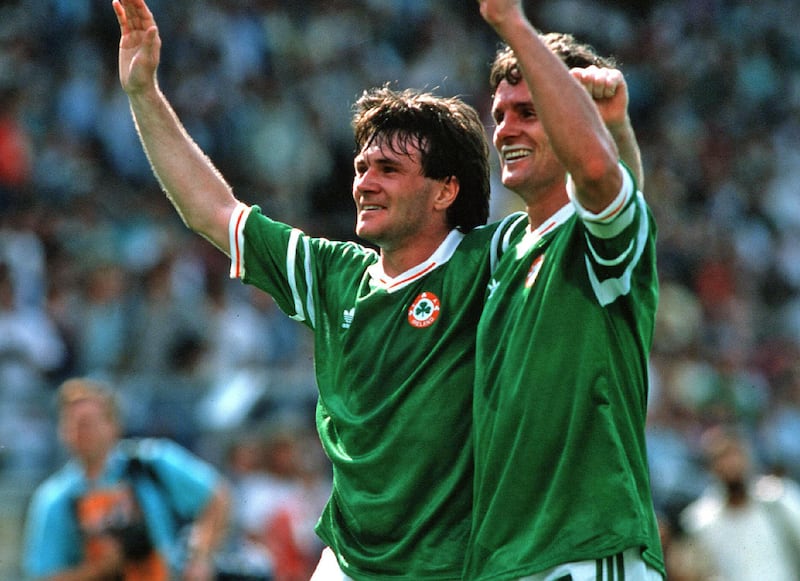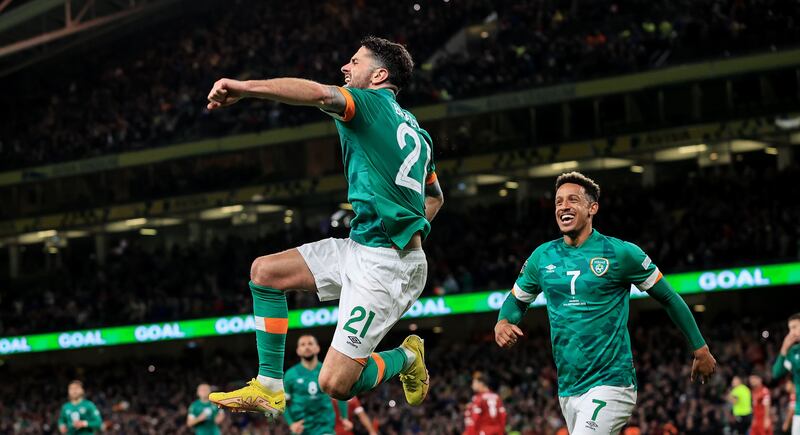Who stuck the ball in the English net? When it happened, Roddy Collins was on a building site in Tiger Bay just outside Cardiff.
“It was a glorious, hot summer,” wrote Collins in his recently-published autobiography The Rodfather. “Ireland had qualified for the European Championship for the first time and they beat England in Stuttgart thanks to a goal from Ray Houghton. I took a twenty-foot-long slating lath and used it to fly a tricolour over the roof of the building that we were working on. I was summoned to see the foreman.”
“McDwyer*,” he said, “do you have any idea what this building is going to be used for?”
“Er, no,” I told him.
Council to run the rule over Portobello house revival as Hugh Wallace deviates from the plan
Irish WWE star Lyra Valkyria: ‘At its core, we’re storytellers. Everything comes down to good versus evil’
Cathy Gannon: ‘I used to ride my pony to school, tie him up and ride him back’
The Guildford Four’s Paddy Armstrong: ‘People thought I was going to be bitter and twisted when I came out of prison’
“It’s going to be a retirement home – for former RAF personnel. So take that f**king flag down.”
(* Collins was working under the name ‘Mick McDwyer’, as he still played for Newport County.)
Thirty-six years later, a full circle of footballing life might bring Ireland back to Stuttgart. At least the Neckarstadion still exists, although nowadays it is called the Mercedes Benz Arena.
The Niedersachsenstadion in Hanover is not among two clusters of five stadia at a seemingly environmentally friendly Euro 2024, so we can forget about reliving Ronnie Whelan’s shinner and Oleh Protasov’s equaliser.
“When Ronnie Whelan scored his spectacular goal against the Soviet Union,” Collins recalled, “I ran the length of the garden and, in my excitement, kicked a flagstone in my bare feet, flaking a bone in the process.”
He was not alone, as a little country lost the run of itself in the summer of 1988. The scene of Wim Kieft’s heartbreaking header in Gelsenkirchen, meanwhile, is no more: the Parkstadion has been partly demolished and replaced by the spectacular indoor Arena AufSchalke nearby.

The 17th European Championship begins on June 14th, 2024 with Germany hosting the second seeds in Group A at Bayern Munich’s Allianz Arena before ending in Berlin’s Olympiastadion on July 14th.
It’s getting back there that’s the problem. The journey of 1,500 kilometres begins with one step in Frankfurt on Sunday, as the great and the good gather under Uefa’s banner for the qualification draw. We expect to ask Stephen Kenny about this and that, and FAI chief executive Jonathan Hall about the ongoing lack of a shirt sponsor. Perhaps the blue-chip firms are waiting to see what opponents come out of the hat above third-seeded Ireland.
Once the winter World Cup concludes at the Lusail Stadium in Qatar on December 18th, the European superpowers will adopt the same interest Ireland currently hold for a draw that will shape everyone’s footballing existence.
Qualification never comes smoothly. Never forget what Jack Charlton managed to achieve by guiding a high-pressing Irish side to Euro 88; an eight-team tournament with seven group winners and the hosts, West Germany (the Berlin Wall fell the following year). Ireland qualified by topping a group containing Belgium – fresh from reaching the semi-finals at Mexico 86 – Bulgaria, Luxembourg and a steely Scotland team.
Kenny would probably swallow that draw if offered to him this morning. Strangely, it is almost possible. Belgium are top seeds, looking even better in 2021 than they did in September 1986 when a late Liam Brady penalty snatched a famous 2-2 draw in Brussels. Scotland, who are seeded second, showed what they can do during the 2-1 defeat of Ireland at Hampden Park last month. Bulgaria and Luxembourg have been drifting in opposite directions, but both are dangerous fourth seeds.
I think Kenny is still seen by fans as an outsider, as ‘not the FAI’. He’s still seen as the rebels’ choice. To stick with Kenny is still giving the two fingers to all ‘them’
“We really wasted those Charlton years,” Kevin Brannigan told The42 Football Family podcast. “We didn’t invest, we didn’t go with the zeitgeist that we had. I think Kenny is still seen by fans as an outsider, as ‘not the FAI’. He’s still seen as the rebels’ choice. To stick with Kenny is still giving the two fingers to all ‘them’.”

Kenny may struggle to stay on the right side of such fervent public opinion if next year’s campaign opens with two draws, a win and a loss, as Big Jack experienced in the shaky months of early 1987. But Brannigan is right about this being a “weird” period in Irish football history. “This is still a transition period of moving out of that [John] Delaney era, into a new era, whatever that new era is.”
Euro 88 was a wildly different time. Irish people had never tasted the joy of a major tournament, having looked on jealously as Northern Ireland reached World Cups in 1982 and 1986.
There was also a wildly different quality of personnel, as illustrated by the team that Jack built and the starting XI Kenny fielded last month in Hampden.
All the complaints voiced about Kenny being afforded two and a half years to re-imagine and re-equip the senior national team will eventually face a reckoning
In Stuttgart, Frank Stapleton led a vastly experienced side, six of whom were born in the UK, with five Liverpool or Manchester United players and three Celtic men in Packie Bonner, Mick McCarthy and Chris Morris. Stapleton left United for Ajax in 1987, but the Dutch loaned him to Derby County, as the Dubliner’s 64 appearances spiked the caps average at 28.
The average age of the Stuttgart team was a solid 28.5, in stark contrast to the current crop’s callow 24.4 and average caps of 23, mainly because 33-year-old James McClean is ticking towards the 100 mark.
The new era, beginning inside Frankfurt’s Festhalle, is about to be defined by results. All the complaints voiced about Kenny being afforded two and a half years to re-imagine and re-equip the senior national team will eventually face a reckoning. Defeats to Armenia, Ukraine and Scotland stubbed them into third place in the Nations League ‘B’ division, placing enormous pressure on breaking a cycle of poor opening gambits in successive campaigns.

Recent results are still being filed under the tag of “young side experiencing growing pains”, but come the two-match window next March, the margin for error will disappear. Finishing third in a group that could contain the Netherlands and France, or Spain and England, will probably see Ireland stumble into a play-off semi-final in March 2024, as three spots for the 24-team tournament are reserved for teams that fail to finish top or runners-up in the 10 groups.
France and England are the sharks in Pot Two as much as Hungary, Switzerland and Poland are welcome opponents from Pot One. That said, the Swiss and the Finns would welcome Ireland from Pot Three over Ukraine, Norway or Sweden.
As fifth seeds, Northern Ireland are guaranteed a bumpy road, but certain teams cannot be drawn with each other due to ongoing or historic wars. Uefa does not deem Belarus’s continued military support of Russia’s invasion of Ukraine as grounds to exclude them from the party, although they cannot draw Ukraine. Same goes for Azerbaijan and Armenia, Spain and Gibraltar, and both Serbia and Bosnia-Herzegovina facing Kosovo unless they meet in the knockout stages of the Euros.
But what about the World Cup?
Yes, the Qatar winter World Cup starts next month, but the draw for the European Championships in Germany – between June 14th and July 14th, 2024 – is this Sunday morning.
When and where is the Euro 2024 draw?
Uefa is livestreaming the draw from 10am on Sunday, October 9th from the Festhalle exhibition centre, Frankfurt.
How does the draw work?
Fifty-three nations go into six seeded categories (with Russia expelled and Germany automatically qualified as hosts) for seven groups of five teams and three groups of six teams.
There’s a slight catch?
Indeed. The four Nations League group winners – the Netherlands, Croatia, Spain and Italy – are placed into the five-team groups so they can participate in the NL finals in the June 2023 window. The other top seeds are Denmark, Portugal, Belgium, Hungary, Switzerland and Poland.
And Pot 2?
Here’s where it gets interesting: France and England lost top seeding after poor Nations League campaigns, so they join Wales, Scotland, Austria, Czech Republic, Israel, Bosnia-Herzegovina, Serbia and Finland.
Who joins Ireland as third seeds?
Ukraine, Iceland, Norway, Slovenia, Albania, Montenegro, Romania, Sweden and Armenia.
And the rest?
Pot 4: Georgia, Greece, Turkey, Kazakhstan, Luxembourg, Azerbaijan, Kosovo, Bulgaria, North Macedonia, Faroe Islands.
Pot 5: Slovakia, Northern Ireland, Cyprus, Belarus, Lithuania, Gibraltar, Estonia, Latvia, Moldova, Malta.
Pot 6: Andorra, San Marino and Liechtenstein will fill out Groups H, I and J.
Who is guaranteed qualification?
Group winners and runners-up automatically qualify for Germany 2024.
That leaves three remaining spots to be decided by 12 teams in the March 2024 play-offs?
Yes. Ireland finished third in a Nations League B division group so they are way down the pecking order, but could still squeeze into a two match play-off system if they finish third in their group. The group winners of Nations League A, B and C divisions are higher up the food chain, but if they have already qualified, they will be replaced by the next best-ranked team in their league. If there are not enough non-qualified teams in the same league, then it filters down to the next league, finishing with League D.
Some countries cannot meet due to historic and current wars . . .
Armenia and Azerbaijan are being kept apart, as are Belarus and Ukraine, and Gibraltar and Spain. Kosovo cannot be drawn with Bosnia-Herzegovina or Serbia, but nothing prohibits these teams from meeting at the actual Euros.
What about the winter rule?
A maximum of two winter venues may be drawn into the same group: Belarus, Estonia, Faroe Islands, Finland, Iceland, Latvia, Lithuania and Norway and several pairings have been declared to represent an excessive travel distance. A maximum of one such pair may be drawn into the same group.
Ireland’s ideal draw?
Switzerland, Finland, Ireland, Faroe Islands, Gibraltar.
Worst case scenario?
Spain, France, Ireland, Turkey, Northern Ireland.






